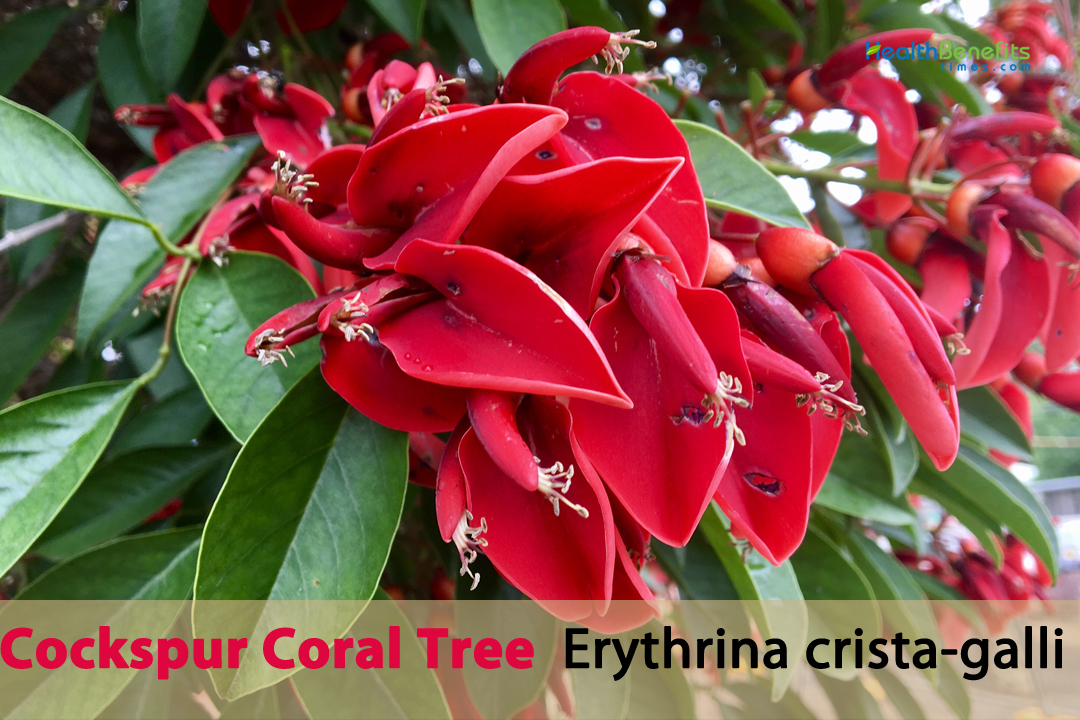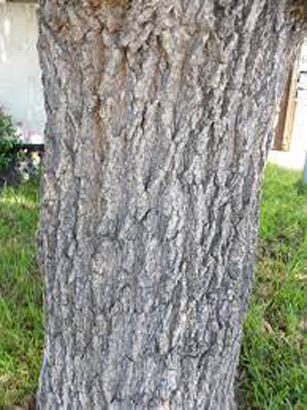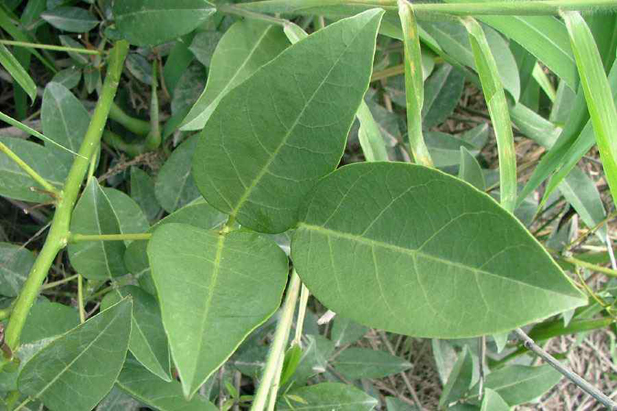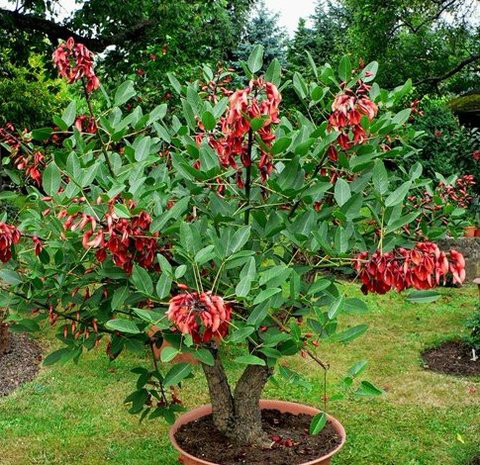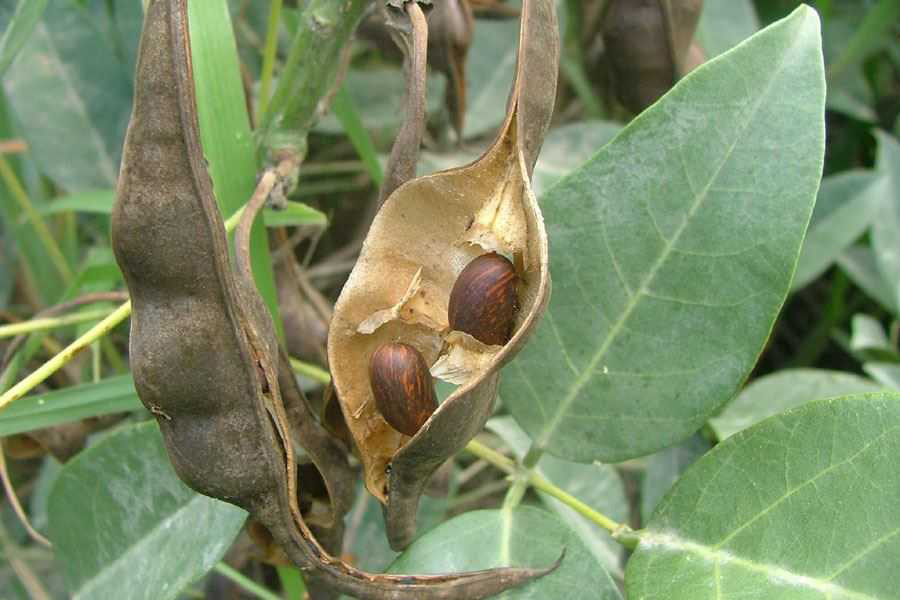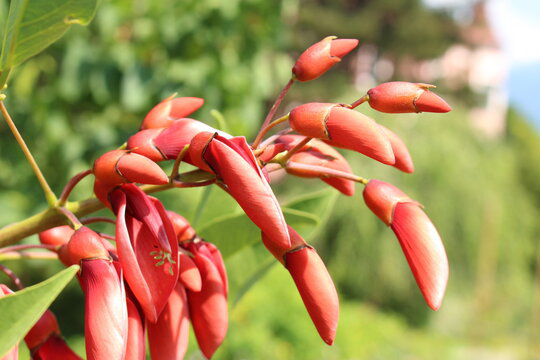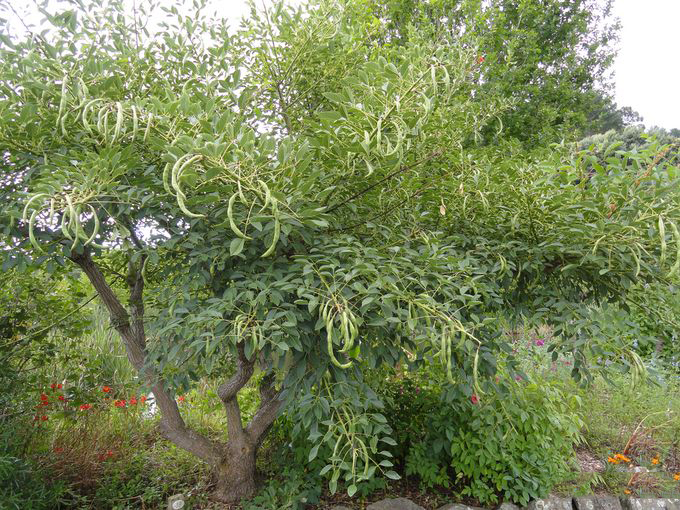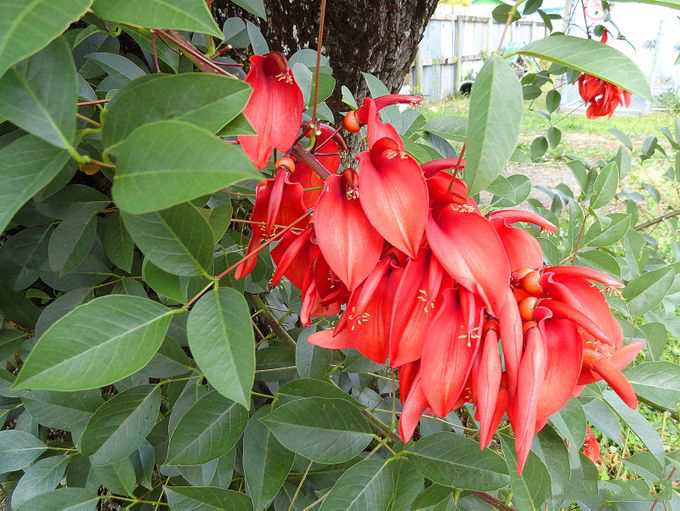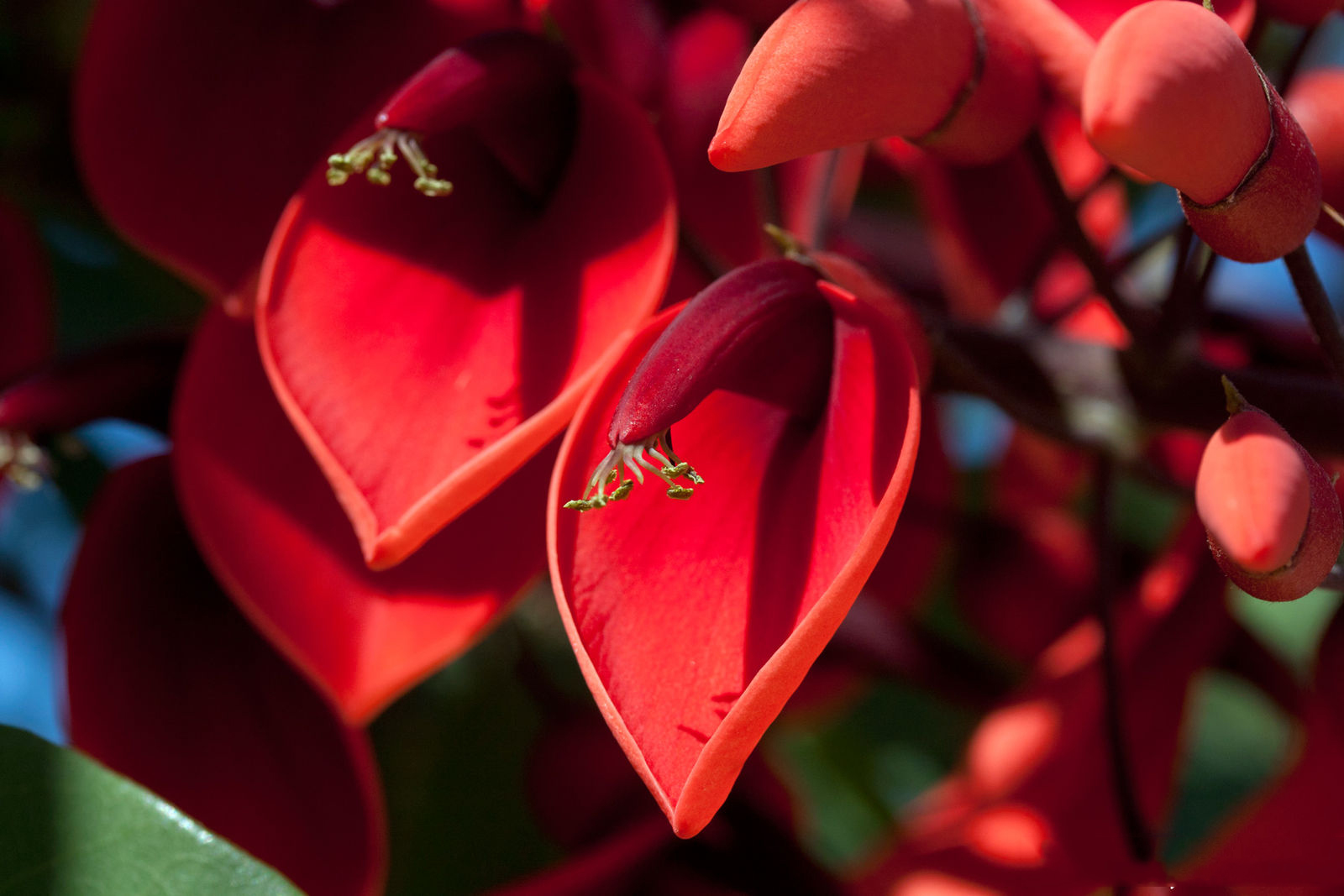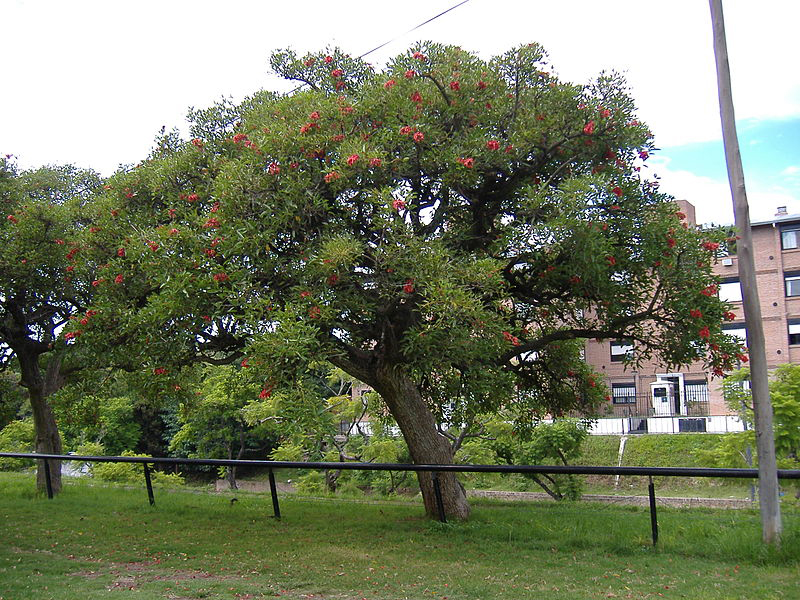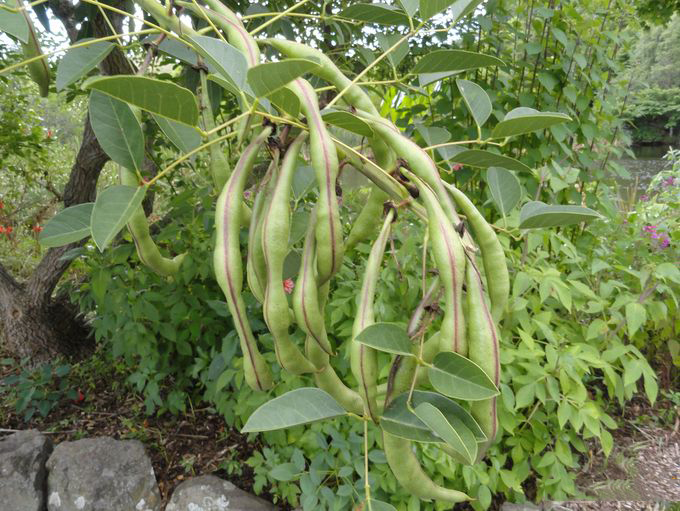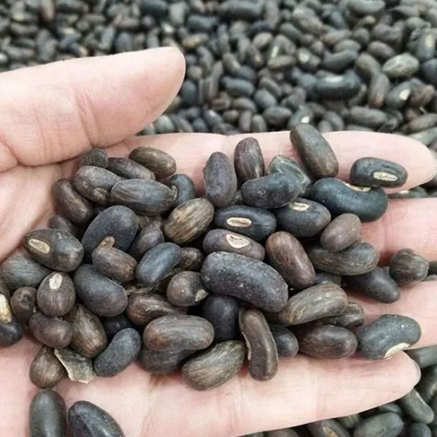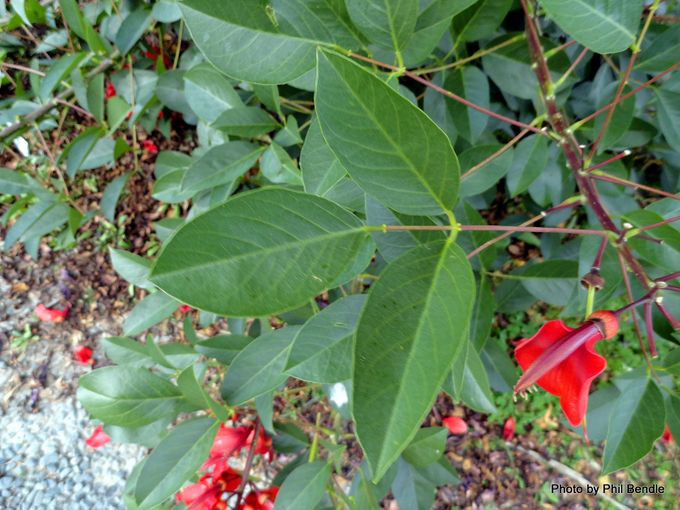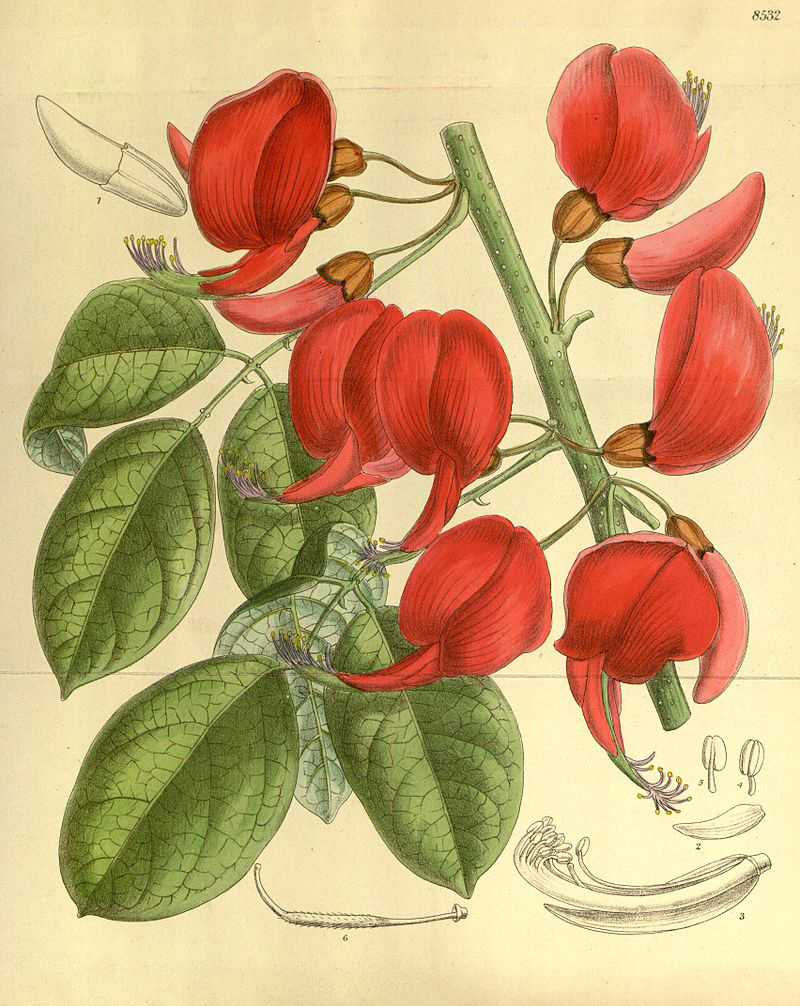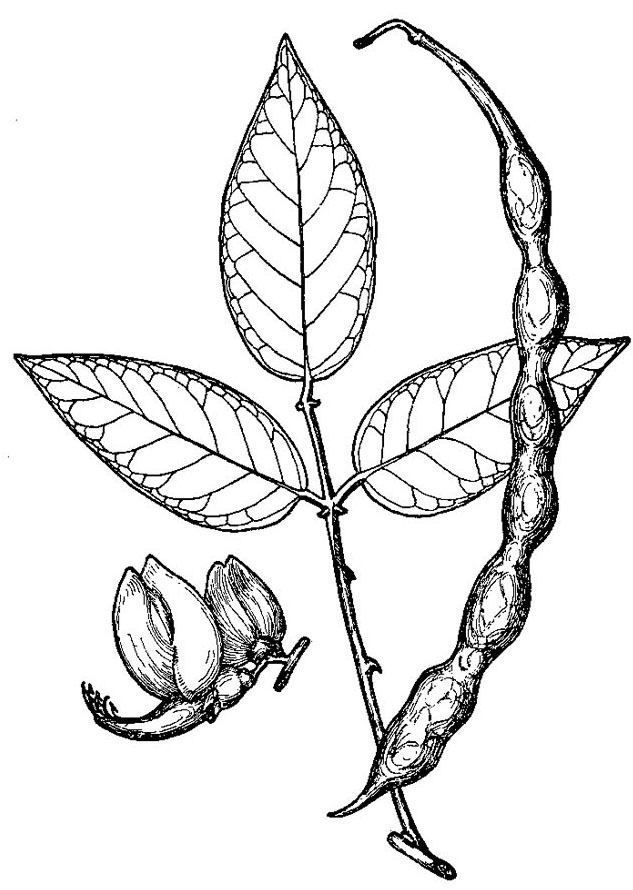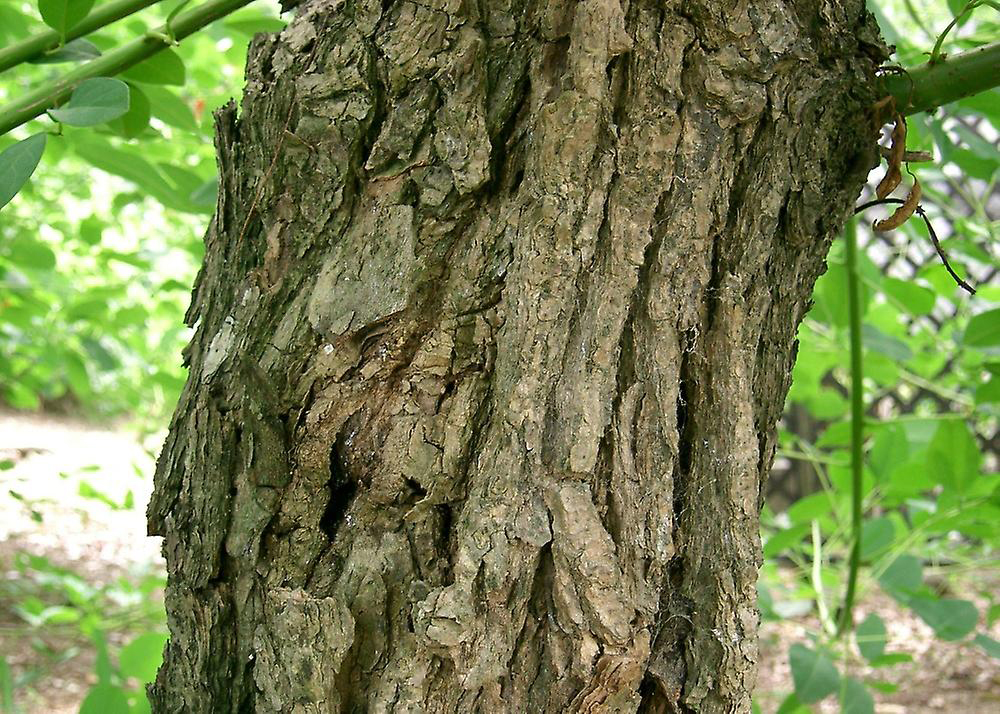| Cockspur Coral Tree Quick Facts | |
|---|---|
| Name: | Cockspur Coral Tree |
| Scientific Name: | Erythrina crista-galli |
| Origin | South America (i.e. eastern Brazil, Bolivia, Peru, Paraguay, Uruguay and northern Argentina) |
| Colors | Initially green turning to dark brown or blackish in color as they mature |
| Shapes | Woody, elongated, cylindrical pods, up to 3 centimeters long |
| Health benefits | Treat coughs and bronchitis, treat skin diseases like eczema and psoriasis, reduce swelling, help wounds heal, relieve pain and treat sore throat |
| Name | Cockspur Coral Tree |
|---|---|
| Scientific Name | Erythrina crista-galli |
| Native | South America (i.e. eastern Brazil, Bolivia, Peru, Paraguay, Uruguay and northern Argentina). |
| Common Names | Cockspur Coral Tree, Cry-baby tree, Coral tree, Coral flame tree, Common coral tree, Swearingen tree, Ceibo, Seibo, Immortal tree, Cock’s comb, Cock’s spur, Argentine coral tree, Uruguayan coral tree, Uruguay coral tree, Brazilian coral tree, Cock’s Claw, Lentisco, Cockatoo’s Comb, Flame Tree, Fireman’s Cap, Sunshine Tree, Crybaby Coral Tree, Tiger’s Claw, cock’s comb coral tree, fireman’s cap, fireman’s cap tree |
| Name in Other Languages | Afrikaans: Koraalboom, Tuin koraalboom Arabic: Shajarat ash-shawk al-bahriyah (شجرة الشوك البحرية) Bengali: Laal Shaak, Lal Tamatar Gachh Bhojpuri: Lal Laathi (लाल लाठी) Bulgarian: Eritrina (Еритрина), Koralov khrast (Коралов храст) Catalan: Seibo Chinese: Jīguān shānhú shù (鸡冠珊瑚树), Ji guan ci tong, Hai hong dou (海紅豆 ), Jīguān cì tong (雞冠刺桐), Xiàngyá huā (象牙花), Jīguān cì tong (鸡冠刺桐), Hǎi hóngdòu (海红豆) Czech: Zarděnice hřebenitá Dutch: Koraalboom, Erythrina English: Cockspur Coral Tree, Cry-baby-tree Finnish: Korallipensas, Kukonkorallipuu French: Arbre de corail, Erythrine crête-de-coq, Érythrine des Mayas du Mexique, Érythrine mères du cacao German: Kamm-Korallenbaum, Krallenginster, Hahnenkammbaum, Hahnenkammkorallenstrauch, Korallenstrauch, Heulsuse, Karibischer Korallenstrauch, Korallenbaum Greek: Dendro tou koralliou (Δένδρο του κοραλλιού) Gujarati: Lal Imli, Lal Ambli Gurung: Rato Tewa (रातो तेवा) Hebrew: אלמוגן כרבולת Hindi: Jangli tamatar (जंगली टमाटर), Kokaspar korl tri (कॉकस्पर कॉरल ट्री), Lal Tamatar, Lal Samudrik Hungarian: Tarajos korallfa Indonesian: Pohon Karang Gading Italian: Albero di corallo, Eritrina crestata, eritrina cresta di gallo Japanese: Ōgonhagi (オウゴンハギ), Kokkusu pā kōrarutsurī (コックスパーコーラルツリー), Hosoba deiko, amerika-deigo (アメリカデイゴ) Kannada: Kempu Gurasu, Kempu Sampige, Kempu Torai Korean: Kokseupeo kollalteuri (콕스퍼 코랄트리) Limbu: Laal Tebo (लाल तेबो) Lithuanian: Argentininė raudūnė Maithili: Lal Laathi (लाल लाठी) Malay: Pokok Karang Gading Malayalam: Chethi, Chethi Thumba, arithreena crista-gali (എറിത്രീന ക്രിസ്റ്റ-ഗാലി) Marathi: Lal Imli, Lal Tamrak, Lal Charoli Nepali: Lal Lakuwa (लाल लकुवा) Newari: Rato Khui (रातो खुइ) Norwegian: Korallbusk Persian: اریترینا کریستاگالی Portuguese: Mulungu, Corticeira, Eritrina, coralina-cristada, eritrina, feijoeiro-da-Índia, corticeira-do-banhado, murungu, samandu, seibo, Corticeira Punjabi: Lal Imli, Lal Ambli Rai: Rato Tebo (रातो तेबो) Russian: Kokspur korallovoe derevo (Кокспур коралловое дерево), Eritrina petushij greben, Eritriny, Eritrina (Эритрина), Eritrina petushij greben (Эритрина петуший гребень), Eritriny (Эритрины ), eritrina petushinyy greben (эритрина петушиный гребень) Spanish: Ceibo, Seibo, Árbol de Coral, Bucaré, Capa-homem, Ceibo, Flor-de-coral, Muchoc, Mulungu, Mulungu-coral, Murungo, Murungu, Pau imortal, Seibo, Suiná-suiná, Totocero, eritrina, gallito, gallitos, picos de gallo Swahili: Mti wa Korali Swedish: Korallbuske Tamil: Semparuthi, Sengal, Lal Sampangi Telugu: Adavi Sampangi, Adavi Tella Sampangi Thai: Ton kan kluay (ต้นก้านกล้วย) Turkish: Tavukburunu Mercan Ağacı Upper Sorbian: Kórarjownik Urdu: Lal Imli, Lal Ambli Vietnamese: Cây san hô, Vông mồng gà |
| Plant Growth Habit | Small to medium-sized, spiny, exotic flowering deciduous tree |
| Growing Climates | Found in parks and gardens, parks, along roadsides, waterways, in swamps and coastal wetlands, in urban bush land, grassland and fields, often bordering rivers and estuaries, open areas |
| Soil | Prefers soil that is loamy, sandy, or clayey with good drainage. Avoid planting it in areas prone to waterlogging, as excessive moisture can lead to root rot |
| Plant Size | About 5-8 meters (16-26 feet) tall with girth of its trunk measuring 50 cm (20 in). Although some individuals can grow up to 10 m (33 ft) |
| Root | Taproot with nodules produced by nitrogen-fixing bacteria |
| Stem | Older stems are brown or greyish in colour and have moderately rough bark. Younger stems are greenish in colour, shiny, and hairless |
| Bark | In young trees, the bark is relatively smooth and greenish-gray, while in older trees, it becomes rougher, darker, and develops vertical fissures |
| Leaf | Alternately arranged leaves are borne on stalks (i.e. petioles) 5-10 cm long and are made up of three leaflets (i.e. they are trifoliate). These leaflets (3-6 cm long and 2-5 cm wide) are egg-shaped in outline (i.e. ovate) or oval (i.e. elliptic) in shape. They are hairless (i.e. glabrous), with entire margins and pointed tips |
| Flowering season |
|
| Flower | Flowers are papilionate, petals 5 centimeters long, separate stamens about 1 centimeter long |
| Fruit Shape & Size | Woody, elongated, cylindrical pods, up to 3 centimeters long |
| Fruit Color | Initially green turning to dark brown or blackish in color as they mature |
| Seed | Large and hard seeds (about 10-15 mm long) are slightly kidney-shaped (i.e. reniform), dark brown or blackish in color, and often with a somewhat mottled appearance |
| Varieties |
|
| Plant Parts Used | Root, bark, leaves, flowers, and seeds |
| Propagation | By Seeds, Stem Cuttings, Air Layering, Grafting |
| Lifespan | About 30 to 50 years or more |
| Season |
|
| Health benefits |
|
Plant Description
The Cockspur Coral Tree is a small to medium-sized, foreign, flowering, leafless tree with a spreading canopy. It has thorny leaves and flowers. The plant usually grows between 5 and 8 meters (16 to 26 feet) tall, and its base is about 50 cm (20 inches) in diameter. Even though some of them can grow up to 10 m (33 ft) tall. The plant grows in parks, gardens, along roadsides, waterways, in swamps and coastal marshes, in urban bush land, grassland, and fields, and often near rivers, estuaries, and open areas. It grows best in sandy, loamy, or clayey soil that drains well. Don’t plant it in places that tend to get flooded, because too much water can cause the roots to rot.
Appropriate growing environment for Cockspur Coral Tree
The Cockspur Coral Tree thrives in specific growing environments. Here are the key considerations for creating an appropriate growing environment for the tree:
- Climate: The Cockspur Coral Tree does well in warm subtropical and mild climates. It likes a temperature where summers are mild to hot and winters are mild. It can handle a wide range of temperatures, but cold is harder on it. Cold can hurt the leaves and stop it from flowering. A place with little or no frost is best for growth.
- Sunlight: The tree does best when it gets at least six hours of straight sunlight per day and is in full sun. Plants grow well and bloom a lot when they get enough sunshine. Putting the tree in a spot where it will get a lot of sunshine will help it grow and bloom in a healthy way.
- Soil: The Cockspur Coral Tree needs dirt that drains well. It grows best in sandy, loamy, or clayey soil that drains well. Don’t plant it in places that tend to get flooded, because too much water can cause the roots to rot. The tree can grow in dirt that is slightly acidic to slightly alkaline.
- Watering: Even though the Cockspur Coral Tree can handle drought once it is established, it needs to be watered regularly, especially during long dry times. Give the dirt enough water to keep it moist, but not so much that it can’t be worked. Change how often you water based on the weather and how much water the tree needs.
- Wind Protection: Strong winds can break the tree’s stems and stop it from growing properly. Consider putting the Cockspur Coral Tree somewhere that naturally blocks the wind, like next to a wall, fence, or bigger trees. If you need to, build a windbreak around the tree to protect it from strong gusts.
- Space Requirements: The Cockspur Coral Tree is a big tree that needs a lot of room to grow and spread. Give it enough room to grow to its full height and width so that it can grow properly and not get in the way of nearby buildings or other plants.
- Pruning: Regular pruning helps keep the form, keep the size in check, and encourage better branching and flowering. During the tree’s dormant season, prune it to get rid of dead or broken branches and give it the shape you want. Don’t prune too much, because it might stop the plant from blooming the next year.
Roots
There is a main taproot that grows from the seedling, and then there are side roots that grow in different directions. Smaller, finer roots called fibrous roots grow from the side roots. Most of the time, the fibrous roots grow near the surface of the dirt rather than deep into the ground. They spread out horizontally and went well past the tree’s top. This helps the tree get a good hold on the ground and take in food more effectively.
Roots with fibers are very important for getting water and nutrients from the dirt. The fine roots’ large surface area makes it easy for the tree to get the water, minerals, and other important nutrients it needs to grow and develop.
Stem
The stem is rigid, straight, and looks like a tube. It is the main thing that holds up the tree’s limbs, leaves, and flowers. As the tree grows older, the stem gets thicker over time. The stem grows many branches that spread out horizontally or grow upwards. The branches grow from nodes on the stem, making a branching design that adds to the shape and structure of the tree’s canopy.
The Cockspur Coral Tree has thorns on its stem and branches, which make it, stand out. Because these thorns are sharp and bent, the tree is often called a “Cockspur.” They protect the tree from being eaten by animals and help keep it from getting hurt. Inside the stem, there are xylem and phloem, which are special kinds of cells. Xylem tissue moves water and nutrients from the ground to the leaves, giving the tree what it needs to stay hydrated and grow. On the other hand, phloem tissue moves sugars and other organic substances made in the leaves during photosynthesis to other parts of the tree.
The cambium is a thin layer of tissue found in the stem. This layer is constantly splitting, which is what makes the stem and branches grow wider. The cambium makes new cells both inside the stem (making xylem) and outside the stem (making phloem). This lets the stem get bigger over time. Lenticels are small, raised parts that may be on the stem. Lenticels are small holes in the bark that allow gas to move between the inside of the stem and the outside air.
Bark
As a tree grows up, its bark changes in texture and color. When trees are young, the bark is smooth and grayish-green. As the tree gets older, its bark gets rougher, gets vertical cracks, and turns a darker grey or brown color. The bark protects the parts of the tree that are closer to the ground. It protects against bodily damage, disease-causing organisms, and pests. The rough roughness and cracks in the bark can make it hard for insects or animals to climb up and get to the tree.
There are small holes in the bark called lenticels. These lenticels make it possible for gases to move between the cells inside the body and the air outside. They make it easier for oxygen to get in and carbon dioxide to get out, which helps the tree breathe. The bark can repair itself and grow back. If the bark gets hurt, the tree can make new bark cells to cover and protect the hurt area. This process of renewal helps keep the stem strong and makes sure the tree stays healthy.
Leaves
The leaves are usually palm-shaped or have three leaflets and are light to dark green in color. Palmate leaves look like a hand because they have several leaflets that spread out from a center point. There are three lobes on trifoliate leaves. Each leaf is made up of several leaflets, usually between three and five. The leaves are either ovate or elliptical in shape, and the edges are either smooth or have a few small teeth. They can be anywhere from 2 to 6 inches long, or 5 to 15 centimeters.
The Cockspur Coral Tree’s leaves are connected to a central stalk called the petiole. The petiole is what links the leaves to the tree’s main stem. When the leaves are young, it may have a reddish color. As with all green plants, the leaves are an important part of the process of photosynthesis. By doing this, the leaves take in sunshine and use it to turn carbon dioxide and water into sugars and oxygen. This gives the tree the energy it needs to grow and develop.
The leaves are shaped and sized to fit the plant’s natural environment. The palmate or trifoliate shape of the leaves helps the plant get the most sunshine and lose less water through transpiration.
Flower
The flowers are grouped together in groups called inflorescences. These groups of flowers can have more than one flower each and grow at the ends of stems or in the spaces between leaves. When in full bloom, the inflorescences can be up to 20 centimeters (8 inches) long and make a beautiful show. The flowers are big and beautiful, and they are usually between 2 and 3 inches long, or 5 to 7 centimeters. They are usually bright red or coral, but some types can be pink or orange. The flowers are joined together, making a tube shape with an upper lip that flares out and a lower lip.
People often say that the shape of the flowers looks like a rooster’s comb or a butterfly. The biggest petal, called the “standard,” is at the top. It acts as a flag or sail, while the keel and wings are made from the smaller petals at the bottom. The flowers are velvety and have clear lines on them. The flower’s sexual parts are the stamens (which are male) and the pistil (which is female). There are many stamens, and most of them are longer than the petals. The pistil is in the middle of the flower. It has three parts: the stigma, the style, and the ovary.
The flowers have a light, pleasant smell that can be stronger or weaker based on the tree and the conditions around it. The Tree usually blooms in the summer, but the exact time can change based on where it is and what the weather is like. The time when the flowers are out is generally only a few weeks long.
Fruits
The fruits are long pods that look like beans and are about 10 to 15 cm (4 to 6 inches) long. They are smooth and usually turn brown or dark brown as they get older. The pods are split into many parts, and each part has a few seeds. The amount of segments can be different, but they are usually lined up in a straight line along the length of the pod. When the pods are ready, they feel hard and leathery.
Even though the fruits aren’t usually used to make food, they can be used to decorate or make crafts. The dried pods can be used to make wreaths, flower arrangements, and other works of art.
Seeds
The seeds are usually about 2 to 3 centimeters (0.8 to 1.2 inches) in diameter, which is pretty big. Most of the time, they are oval or round and have a hard, woody shell. The seeds have a thick, hard coat on the outside that protects the baby inside. Most of the time, the seed coat is brown or black and has a rough or wrinkly surface.
It’s important to remember that the seeds and other parts of the tree have chemicals that make them poisonous. If the seeds are eaten, they can make you sick, so you should be careful not to eat them by mistake. Even though most people don’t eat the seeds of the Cockspur Coral Tree, they are important culturally and as decorations in some places. In some countries, the seeds are used to make traditional crafts, jewelry, and decorations for other kinds of art.
Varieties of Cockspur Coral Tree
There are several varieties and cultivars of the Cockspur Coral Tree that have been developed for their unique characteristics. Here are some notable varieties:
- Erythrina crista-galli ‘Compacta’: This variety is known for growing in a compact way, which makes it good for small areas or growing in containers. It usually grows to be about 2-3 meters (6-10 feet) tall and spreads out less than that. Even though it is small, it still has the bright red flowers and prickly branches that are typical of the species.
- Erythrina crista-galli ‘Alba’: This type of coral tree is often called the “White Cockspur Coral Tree” because it has white flowers instead of the usual red ones. It grows flowers that are white or a creamy white color instead of the usual red. The white flowers stand out against the green leaves and give the plant a unique look.
- Erythrina crista-galli ‘Flore Pleno’: The double flowers on this type make it stand out. The flowers of ‘Flore Pleno’ have an extra layer of petals that make them look like they are full and double. Because of this, the tree’s flowers are more beautiful and eye-catching.
- Erythrina crista-galli ‘Pink Powder puff’: This cultivar showcases pink flowers instead of the usual red color. The pink powder puff-like flowers lend a softer and more delicate aesthetic to the tree. This variety is especially sought after for its unique and charming pink blooms.
- Erythrina crista-galli ‘J.C. Williams’: This variety, which was named after the famous plant collector J.C. Williams, is known for its big, bright red flowers. The flowers of ‘J.C. Williams’ are known for their bright colors and beautiful arrangements. It is thought to be a standout type because of the size and depth of color of its flowers.
- Erythrina crista-galli ‘Variegata’: This variety has leaves that are both green and white or cream-colored. The tree is an eye-catching main point in the yard even when it is not in bloom because of its interesting, different-colored leaves.
- Erythrina crista-galli ‘Lucky Strike’: The petals of this type have a very interesting pattern of colors. The top flowers are bright red and have a yellow center that makes them look like flames. The unusual colors of ‘Lucky Strike’ make for a dramatic and eye-catching show, making it a great choice for giving the garden more visual impact.
History
It is not clear where the Cockspur Coral Tree is from. It is thought to have come from South America, especially Argentina, Uruguay, or Brazil. People know that the tree grew well in the warm and temperate parts of these countries. Explorers from Spain and Portugal brought the Cockspur Coral Tree back to Europe in the 16th and 17th centuries. Its beautiful red flowers and thorny branches caught the attention of botanists and gardeners, who started growing it in botanical parks and on private estates all over Europe.
The Cockspur Coral Tree spread to other parts of the world because it was so famous. After that, it was brought to North America, including the United States, where it was grown as a decorative tree in warmer areas. It also went to Asia, Australia, and other parts of the world.
Health benefits of Cry-baby tree
Cockspur Coral Tree or the Cry-baby tree is a deciduous flowering tree native to South America. While it is primarily known for its ornamental value, it also has a few potential health benefits. Here is some possible health benefits associated with Erythrina crista-galli:
1. Anti-inflammatory properties
There are bioactive chemicals in the Cockspur Coral Tree that reduce inflammation. Flavonoids and phenolic acids, for example, have been shown to stop inflammatory enzymes from doing their jobs and stop the body from making more inflammatory molecules. By lowering inflammation, this tree may be able to help people with arthritis, asthma, and inflammatory skin diseases.
2. Analgesic effects
In traditional medicine, the Cockspur Coral Tree has been used to relieve pain. The bark and leaves of a tree have alkaloids and other chemicals that may help relieve pain. When applied to the skin or taken by mouth, products made from the bark may help relieve pain from things like headaches, toothaches, and muscle aches.
3. Antimicrobial activity
Different types of bugs and fungi have been killed by the Cockspur Coral Tree. Studies have found bioactive substances in the tree, such as flavonoids and alkaloids, which stop pathogenic microorganisms from spreading. Because of these qualities, it seems like the Cockspur Coral Tree might be able to fight some bacterial and fungal diseases.
4. Antioxidant benefits
There are a lot of antioxidants, like flavonoids and phenolic substances, in the Cockspur Coral Tree. Antioxidants help the body get rid of dangerous free radicals, which lowers oxidative stress and keeps cells from getting hurt. If you eat foods or extracts made from the Cockspur Coral Tree, it may help your body’s antioxidant defense and possibly lower your chance of chronic diseases linked to oxidative damage.
5. Respiratory support
In traditional medicine, the Cockspur Coral Tree was used to treat breathing problems like coughs, pneumonia, and asthma. It is thought to have properties that help loosen and get rid of mucus in the respiratory system. This makes it easier to breathe and clears the airways.
6. Digestive aid
Cockspur Coral Tree has been used for a long time to help the digestive system. People think that it has carminative qualities that can help relieve digestive problems like bloating, gas, and indigestion.
7. Wound healing
People have put the bark and leaves of the Cockspur Coral Tree on wounds to help them heal. It is thought to have qualities that can help soothe and protect the skin, speed up the healing of tissues, and lower the risk of getting an infection.
Traditional uses and benefits of Cockspur Coral Tree
- Different parts of the Cockspur Coral Tree have been used in traditional medicine to treat a wide range of illnesses.
- It has been used to treat coughs and bronchitis, help with digestion, speed up the healing of wounds, and treat skin diseases like eczema and psoriasis.
- They are used to treat problems with the lungs, reduce swelling, help wounds heal, and relieve pain.
- Brazil’s native tribes use several kinds of Erythrina as insecticides, fish poison, medicines, and sleep aids.
- A strong sleep aid is made from a decoction of the leaves.
- Rheumatism and hepatitis are treated with it.
- A gargle made from a mixture of the bark is used to treat a sore throat, and a wash made from the bark is used to treat cuts.
Culinary Uses
Most of the time, Cockspur Coral Tree is not used in food. Seeds, flowers, and other parts of the tree, like alkaloids, are poisonous and can hurt you if you eat them.
When eating plants, it’s important to put safety first, and in the case of the Cockspur Coral Tree, it’s not a good idea to eat it. There are a lot of other plants and products that can be used safely in cooking and making food.
Different Uses of Cockspur Coral Tree
The Cockspur Coral Tree has various uses beyond culinary purposes. Here are different uses of the Cockspur Coral Tree in detail:
- Ornamental Value: The Cockspur Coral Tree is very popular as a decorative plant. Its bright red flowers, unusual shape, and thorny branches make it a popular choice for landscaping and adding visual appeal to gardens, parks, and public areas. The striking look of the tree can be a focus point and add to the beauty of the landscape as a whole.
- Symbolism and Cultural Significance: In the places where it grows naturally, the tree has cultural and spiritual meaning. It is the national flower of Argentina and stands for courage, passion, and the fight for freedom. In different cultures, the bright red flowers of this tree have been linked to power and resiliency.
- Medicinal Potential: Even though scientific study is limited, different parts of the Tree have been used in traditional medicine to treat illnesses. In traditional medicine, bark, leaves, flowers, and seeds have been used to treat lung problems, reduce inflammation, help wounds heal, and ease pain. But care should be taken, and it’s best to talk to a doctor before using the tree as medicine.
- Craft and Art: In traditional craft and art, the thorny stems, colorful flowers, and unique seed pods have all been used. People have used the thorns to make jewelry, decorations, and to add details to traditional crafts. People have used the dried seed pods in flower arrangements, wreaths, and other works of art.
- Nitrogen Fixation: Like other plants in the Erythrina group, it has special root nodules that can fix nitrogen from the air. This process helps plants grow by turning nitrogen gas into a form that plants can use. This makes the soil richer and helps the plants around it.
- Wildlife Attraction: People who like to watch birds know that hummingbirds are attracted to bright red flowers, which makes this plant a great addition to parks and landscapes. These beautiful and quick-moving birds eat the nectar-rich plants, which add to the diversity of the area.
- Soil Stabilization: Large root systems help stabilize the soil, especially in places where it is likely to wash away. The roots hold the soil together, making it less likely to wash away and helping to protect the soil.
- Natural Dye: You can get a natural dye from flowers. When the bright red petals are boiled or soaked, they make a dye that can be used to color fabrics, yarns, and even paper or paint for artistic reasons.
- Livestock Feed: In some places, the leaves have been used to feed animals, especially cattle. The leaves are high in protein and can be used as an extra source of food, especially when there isn’t enough grass.
- Bee Forage: Honeybees like to eat nectar-rich flowers because they are a good source of food. Beekeepers could put these trees in a way that feeds their honeybee colonies and helps them make more honey.
Side effects of Cockspur Coral Tree
The seeds, flowers, and other parts of the Cockspur Coral Tree, especially the alkaloids, are poisonous. If the tree is eaten or touched, it can cause a number of side effects and possible health risks. Here are detailed side effects associated with the Cockspur Coral Tree:
- Gastrointestinal Disturbances: If you eat any part of the Tree, especially the seeds, it can cause serious stomach problems. This can lead to feeling sick, throwing up, having stomach pain, diarrhea, and sometimes even bloody stools.
- Neurological Effects: The tree has dangerous alkaloids that could damage the central nervous system. This can cause signs like dizziness, confusion, headache, tremors, muscle weakness, and in the worst cases, convulsions or seizures.
- Cardiovascular Effects: If you eat the Cockspur Coral Tree, it can affect your heart. It can cause changes in heart rate, abnormal heart beats, high blood pressure, and in the worst cases, cardiac toxicity.
- Respiratory Problems: If you breathe in the pollen or other parts of the Cockspur Coral Tree, it can irritate your lungs and make you allergic. This can cause coughing, breathlessness, shortness of breath, tightness in the chest, and, in the worst cases, trouble breathing or anaphylaxis.
- Skin Irritation and Allergic Dermatitis: When the sap or other parts of the Cockspur Coral Tree come in contact with the skin, it can become irritated, red, itchy, and even develop allergic dermatitis. Some people may get a rash or boils when they touch it.
- Eye Irritation: When the eyes come into direct touch with the Cockspur Coral Tree’s sap or pollen, they can get red, itch, tear, and feel uncomfortable. In the worst cases, it can cause conjunctivitis or infection of the eye.
References:
https://en.wikipedia.org/wiki/Erythrina_crista-galli
https://www.inaturalist.org/guide_taxa/285492
http://www.stuartxchange.com/CoralTree.html
https://www.itis.gov/servlet/SingleRpt/SingleRpt?search_topic=TSN&search_value=26676#null
https://npgsweb.ars-grin.gov/gringlobal/taxon/taxonomydetail?id=15739
https://www.missouribotanicalgarden.org/PlantFinder/PlantFinderDetails.aspx?taxonid=280318
https://pfaf.org/user/Plant.aspx?LatinName=Erythrina+crista-galli
https://gd.eppo.int/taxon/ERZCG
https://indiabiodiversity.org/species/show/264607
http://www.theplantlist.org/tpl1.1/record/ild-2683
https://keyserver.lucidcentral.org/weeds/data/media/Html/erythrina_cristagalli.htm
http://www.flowersofindia.net/catalog/slides/Cockspur%20Coral%20Tree.html
https://www.wikidata.org/wiki/Q162849
https://plants.usda.gov/home/plantProfile?symbol=ERCR6


